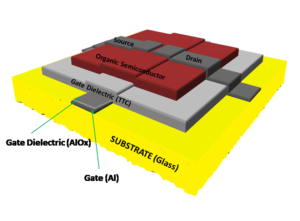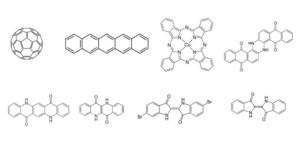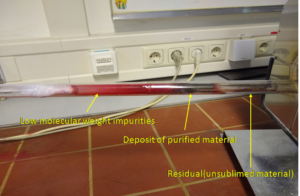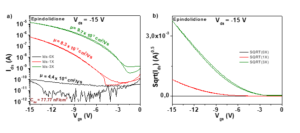In their recent paper in Materials Chemistry Frontiers, published by the Royal Society of Chemistry, the authors Cigdem Yumusak, Niyazi Serdar Sariciftci, Mihai Irimia-Vladu, from the Linz Institute for Organic Solar Cells (LIOS), Physical Chemistry at the Johannes Kepler University Linz, Austria investigated the effects of purification of different organic semiconductors (i.e. n-type, p-type, and ambipolar) in performance of organic field effect transistors (OFETs). The results clearly indicate that performance for the field of organic field effect transistors can be enhanced orders of magnitude by the purification.
 Fig. 1: Schematic view of the OFET architecture
Fig. 1: Schematic view of the OFET architecture
Organic semiconductors are interesting through their versatility in high throughput at low cost of production. For achieving the coveted goal of “green” and sustainable electronics development, one can tailor and make these materials biocompatible and biodegradable. The large-scale electronic waste produced in the world is creating trouble in the supply chain of rare earth materials as well as plastic waste contamination in oceans, due to packaging materials in general. Both these unfortunate events can be faced successfully if we introduce the biodegradable organic semiconductors, substrates and plastics.
Back in 2011 there were already crystalline OFETs with the mobility values exceeding those of amorphous silicon. Nevertheless, reaching values of field effect mobility in excess of 10 cm2/Vs remains a tremendous challenge for organic semiconductors and rather difficult to materialize at the same time. More often than not, organic electronic devices are fabricated with the “as received” materials carrying the declared purity by the chemical supplier. Nevertheless, when the effort of purification was invested, then the results improved impressively, with the recorded mobility of the organic semiconductor reaching record values in excess of 5 cm2/Vs for single crystal based OFETs with rubrene. Importantly also, time of flight measurements at low temperature of ultra-pure oligomeric systems of organic semiconductors showed that mobilities of 10 cm2/Vs at room temperature and of several hundred cm2/Vs at low temperatures are possible to achieve.
In this work, authors tackle the issue of materials’ purity and its influence on organic electronic devices systematically. They compared the effect of different materials as well as different purification degrees respectively, on the performance of fabricated devices. This is to demonstrate systematically the influence of this “purification versus performance” relationship. For this study a large pool of organic semiconductor materials, with n-, p-, and ambipolar-type of charge transport were investigated. The selected semiconductors for this study were: fullerene (C60), pentacene, copper phthalocyanine, indigo (vat blue 1), Tyrian purple, epindolidione, quinacridone and indanthrene blue RS (vat blue 4), the latter 5 molecules belonging to the group of hydrogen bonded (bio)-organic semiconductors.
 Fig. 2: Molecular structure of the organic semiconductors used in this study: (from upper left to lower right) Fulleren C60, pentacene, copperphtalocyanine, indanthrene Blue RS, quinacridone, epindolidione, Tyrian purple (dibromoindigo) and indigo.
Fig. 2: Molecular structure of the organic semiconductors used in this study: (from upper left to lower right) Fulleren C60, pentacene, copperphtalocyanine, indanthrene Blue RS, quinacridone, epindolidione, Tyrian purple (dibromoindigo) and indigo.
The method of purification of the organic semiconductors investigated in this study was the train sublimation method shown in Fig.3.
 Fig. 3: Photograph of the train sublimation oven showing the sublimed material in the vacuum tube
Fig. 3: Photograph of the train sublimation oven showing the sublimed material in the vacuum tube
As an example of the effect of purification take a look at the increase of field effect mobility by several order of magnitude by different purification steps using epindolidione.
 Fig. 4: a) Comparison of OFET devices with three different purity grades of epindolidione semiconductor: unpurified (0X in graph legend), one time purified (1X in graph legend) and three times purified respectively (3X in graph legend); b) the Sqrt(Ids) vs. Vgs of the three purity grades presented in panel a)
Fig. 4: a) Comparison of OFET devices with three different purity grades of epindolidione semiconductor: unpurified (0X in graph legend), one time purified (1X in graph legend) and three times purified respectively (3X in graph legend); b) the Sqrt(Ids) vs. Vgs of the three purity grades presented in panel a)
Indeed, starting from very low field effect mobility of the “as received” material of 4.4×10-6 cm2/Vs, epindolidione based OFETs almost reached the mobility of 0.1 cm2/Vs after being subjected to three steps of purification. This tremendous mobility improvement was accompanied by a decrease of the subthreshold swing from 11.3 V/dec. to 1.9 V/dec. and an increase of the ON/OFF ratio from 3.5 to 3.5×104, literally a 10000-fold improvement.
Authors:
Çiğdem Yumuşak is postdoctoral researcher at the Linz Institute for Organic Solar Cells (LIOS) and Physical Chemistry at the Johannes Kepler University of Linz, Austria. She completed her BSc., MSc., and PhD degrees in Physics at the Yildiz Technical University, Istanbul, Turkey. Her scientific interests focus on semiconductor physics, bio-origin materials and their implementation into organic electronic devices, and bioelectronics.
Niyazi Serdar Sariciftci is Ordinarius Professor for Physical Chemistry and the Founding Director of the Linz Institute for Organic Solarcells (LIOS) at the Johannes Kepler University of Linz/Austria. He graduated as PhD in physics in Vienna. After postdoctoral study at the University of Stuttgart he joined the Institute for Polymers and Organic Solids at the University of California, Santa Barbara, USA. Since 1996 he moved to Linz. He is the inventor of conjugated polymer and fullerene based “bulk heterojunction” solar cells. Prof. Sariciftci published over 600 publications and with over 75000 citations he is one of the most cited scientists in material science (2011, Thompson Reuter ranking No: 14 of the world in material science). He is a corresponding member of the Academy of Science in Austria (ÖAW) and a member of the Turkish Academy of Sciences in.
Dr. Mihai Irimia-Vladu obtained his PhD from the Materials Engineering Department of Auburn University, Alabama, USA in August 2006, under the guidance of Prof. Jeffrey Fergus. He moved to Johannes Kepler University in Linz, Austria as a post-doctoral researcher in the groups of the late Prof. Siegfried Bauer (Soft Matter Physics) and Prof. Niyazi Serdar Sariciftci (Physical Chemistry) where he initiated research activity on biocompatible and biodegradable materials for electronics. After an employment at the Department of Surface Technologies and Photonics of Joanneum Research mbH in Weiz, Austria, Dr. Mihai Irimia-Vladu is back at Johannes Kepler University Linz as Assistant Professor in the Department of Physical Chemistry, where he continues his research investigations of environmentally friendly materials for bioelectronics and energy harvesting devices development.
Article information:
Purity of Organic Semiconductors as a Key Factor for the Performance of Organic Electronic Devices
Cigdem Yumusak, Niyazi Serdar Sariciftci and Mihai Irimia-Vladu
Mater. Chem. Front., 2020, Accepted Manuscript
https://doi.org/10.1039/D0QM00690D













